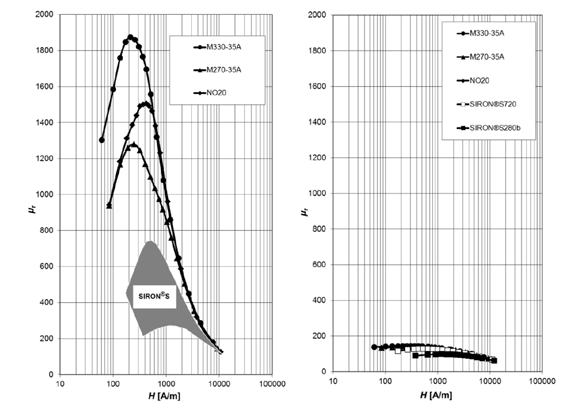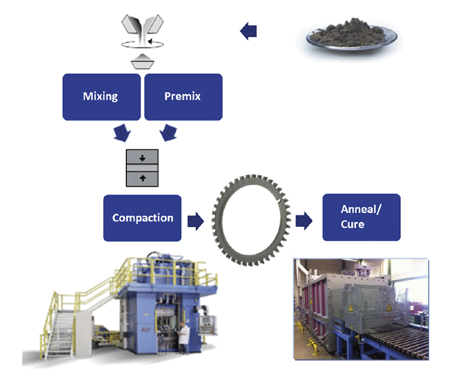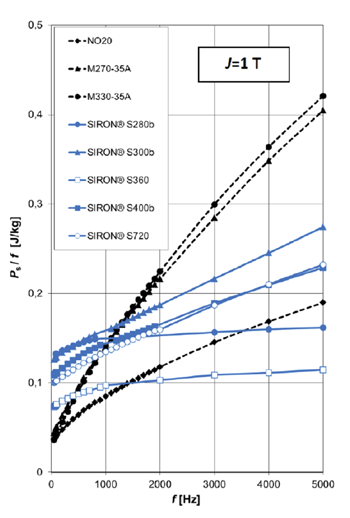2013 Hagen Symposium: Challenges in the manufacture of soft magnetic PM components
Schoppa reported that the trend towards electrically powered vehicles creates the requirement for the highly efficient utilisation of energy resources using high performance electric motors and sensors. The optimised application of soft magnetic materials is regarded as a key factor in enhancing the power densities of electric motors.
Although more than 95% of the world market for soft magnetic materials is served by sheet stacks, PM Soft Magnetic Composites have recently started enjoying increased attention from design engineers due to the possibility of producing more complex soft magnetic cores than can be achieved from stacked sheet. While shapes made from sheet are essentially limited to two dimensions and the third dimension is constant, components made from SMC materials can be designed in three dimensions (Fig. 1) and the dimensional accuracy and reproducibility is excellent.
Processing SMC materials
The typical process for SMC components starts by mixing iron powder with a lubricant or binder, followed by compaction and annealing at temperatures between 200 and 700°C (Fig. 2). The annealing process is exclusively intended for curing the binder, not for sintering the iron powder. The powder particles must be electrically isolated from each other in order to achieve the desired material properties.
The process poses a number of challenges for reaching optimum magnetic material properties and consistently high quality. Mixing should ensure a homogeneous distribution of the lubricant or binder. Usually premixes are used that come mixed with the lubricant. Quality control is therefore done by the powder supplier. Care must be taken to avoid the formation of agglomerates during storage.
For optimum magnetic properties the powder is pressed to a density of 7.3 – 7.6 g/cm³ at compacting pressures up to 800 MPa. Additional die lubrication and heating the dies to 140°C can help to enhance the density of the compacts. Die lubricants should be temperature resistant and uniformly applied to the die walls, for example with a spray system. During compaction the lubricant should not penetrate into the base material nor leave detrimental residues after annealing. Some commercial die lubricants leave sulfur and oxygen containing residues that have a negative effect on the magnetic properties.
The annealing process, usually performed in continuous furnaces, determines the strength and final dimensional tolerances as well as the magnetic properties of the finished components. The atmosphere varies; it can be air with or without subsequent steam treatment or nitrogen. Suppliers of premixes usually recommend the annealing parameters. For in-house developments these parameters are usually oriented towards the curing conditions of the binder. For reproducible results it is essential that all furnace parameters, in particular the heating and cooling profiles, are strictly controlled.
Depending on the required volumes and the geometrical complexity of the parts it may be advantageous to save tooling costs by machining the components from blanks or preforms. Certain SMC materials can be machined and the machined surfaces are smooth and uniform. Magnetic properties are hardly affected, so designers do not have to introduce correction factors as they do with machined stacks of sheet.
Electromagnetic properties of SMC materials
High speed electric motors operating at up to 20,000 rpm, stated Schoppa, are increasingly used in electro-mobility applications. These high speeds are realised with multi-pole motors that are operated at frequencies between 500 and 5000 Hz. Energy losses inside the ferromagnetic materials are composed of the hysteresis losses, the classical eddy current losses, and anomalous losses depending on the current frequency and grain size of the material.
In lamellar sheet stacks these losses arise in the lamellae and additionally in the individual grains of the microstructure. In SMCs, by contrast, energy losses arise only from the powder particles which are electrically isolated. So, if the total losses are considered as a function of the frequency, PM Soft Magnetic Composites have lower losses at higher frequencies than sheet stacks and enhance the performance and efficiency of the motor (Fig. 3).
According to Schoppa, designers of electric motors often complain that PM SMCs have lower permeabilities than metal sheet. While this is true for magnetic circuits without air gaps at frequencies below 1000 Hz, Schoppa claimed that the difference is hardly noticeable at higher frequencies and in magnetic circuits with an air gap (Fig. 4).

Fig. 4 Relative permeability of SIRONTM SMC materials and sheet stacks at 1000 Hz without air gap (left) and with 0.6% air gap in a magnetic circuit (right) (Courtesy PMG Füssen)
SMC materials are characterised with tests that are common and well established for metal sheet and other soft magnetic materials. Energy losses as a function of the frequency are measured on ring cores of solenoids. It is important to know that the results are affected by the geometry of the test samples and that comparisons between different materials should be made using the same sample geometry. The inductivity of a solenoid with a soft magnetic core measured in an LCR circuit at various frequencies is an easy and feasible method to compare materials and to check the product quality. The static magnetic properties, for example saturation induction and coercive force, are measured in a coercimeter and a low electric conductivity is required for low eddy current losses.
The benchmarks in soft magnetic applications are stacked sheet parts which are produced in high quantities at low cost. Schoppa suggested that the benefits of PM SMCs for electromagnetic applications should be communicated to electrical design engineers and more cost effective PM processes, with excellent reproducibility, should be developed in order to fully exploit the potential of these materials. In his opinion new standards for quality assurance of SMC materials are urgently required.
Author: Dr Georg Schlieper, Gammatec Engineering GmbH, Germany
Dr.-Ing. Georg Schlieper, physicist, received his PhD at the Insitute for Materials and Solid State Research of the University of Karlsruhe, Germany. He worked for 15 years in product and process development for the Powder Metallurgy industry where he focused on high strength sintered steels, heat treatment, surface technology, magnetic materials and metal injection moulding. Since 1994 he has worked independently as a consultant. Email: [email protected]
Download FREE PM Review magazine | News | Articles | Subscribe to e-newsletter








